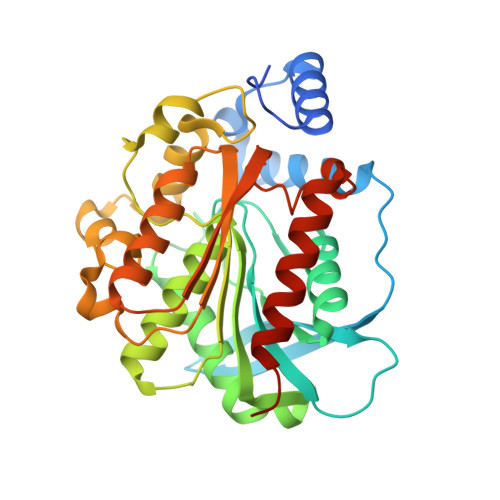Crystal structures of Pseudomonas putida esterase reveal the functional role of residues 187 and 287 in substrate binding and chiral recognition
Dou, S., Kong, X.D., Ma, B.D., Chen, Q., Zhang, J., Zhou, J.H., Xu, J.H.(2014) Biochem Biophys Res Commun 446: 1145-1150
- PubMed: 24680822
- DOI: https://doi.org/10.1016/j.bbrc.2014.03.072
- Primary Citation of Related Structures:
4OB6, 4OB7, 4OB8, 4OU4, 4OU5 - PubMed Abstract:
A recombinant carboxylesterase (rPPE) from Pseudomonas putida ECU1011 was previously cloned and engineered to give a potential application for resolving chiral α-hydroxy acids including mandelic acids and derivatives. Two variants rPPEW187H and rPPED287A showed a ∼100-fold increase in activity towards rac-2-acetoxy-2-(2'-chlorophenyl) acetate (rac-AcO-CPA), but rPPED287A had a significant decrease in enantioselectivity (E=8.7) compared to rPPEW187H and the wild-type rPPE (rPPEWT) (E>200). Here we report the crystal structures of rPPEWT and rPPEW187H, both by themselves and in complex with the substrate, to elucidate the structural basis of this phenomenon. An inactive mutation of nucleophile residue S159A was introduced to obtain the structure of rPPES159A/W187H complexed with (S)-AcO-CPA. The structural analysis reveals that the side chain of residue Asp287 in rPPEWT would have a potential steric conflict with (S)-AcO-CPA when the substrate binds at the active site of the enzyme. However, the mutation W187H could facilitate the relocation of Asp287, while D287A directly eliminates the hindrance of Asp287, both of which offer sufficient space for the binding and hydrolysis of substrate. Moreover, Asp287 generates one site of the "three-point attachment model" as a hydrogen-bond donor that determines the excellent enantioselectivity of rPPE in chiral recognition, and D287A would obviously destroy the hydrogen bond and result in the low enantioselectivity of rPPED287A.
Organizational Affiliation:
State Key Laboratory of Bioreactor Engineering, East China University of Science and Technology, Shanghai 200237, China; Shanghai Institute of Organic Chemistry, Chinese Academy of Sciences, Shanghai 200032, China.
















